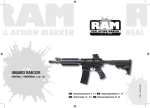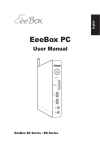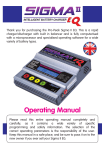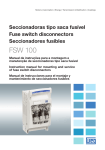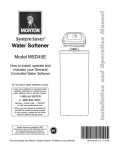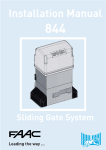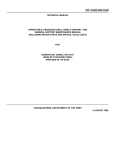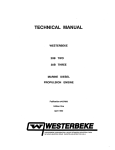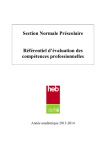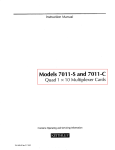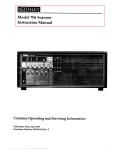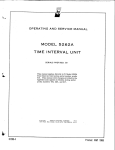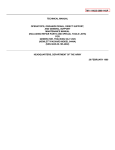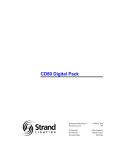Download HP204B Manual
Transcript
HP Archive This vintage Hewlett Packard document was preserved and distributed by www. hparchive.com Please visit us on the web ! Thanks to on-line curator: Kenneth Kuhn for supplying and scanning this vintage document. OPERATING AND SERVICE MANUAL MODEL 2 0 4 B SERIALS P R E F I X E D : 416- OSCILLATOR Copyright 01369-4 HEWLETT-PACKARD COMPANY I962 P r i n t e d : JUNE 1964 Model 204B Index SECTION I GENERAL I N F O R M A T I O N SECTION II INSTALLATION S E C T I O N 111 SECTION IV PRINCIPLES O F O P E R A T I O N SECTION V SECTION VI I 01369-1 OPERATION MAINTENANCE REPLACEABLE P A R T S iii Table of Contents List of Illustrations List of Tables Model 204B T A B L E OF C O N T E N T S Section Page I GENERAL INFORMATION 1-1 1-1 . Introduction . . . . . . . . . . . 1-1 1-4. Power Supply 1-1 1-6 . Mercury and Rechargeable Batteries 1-1 1-8 Accessories Available 1-1 1-10. Instrument Identification . . . . . 1-1 . . . . . . . . . . . . . . . . . . . . . . . . . I1 111 INSTALLATION . . . . . . . . . 2-1 . Inspection . . . . . . . . . 2-4 Rack / Bench Instructions 2-6 . Combining Case . . . . . 2-8 . Adapter F r a m e . . . . . 2-10 Battery-Powered Oscillators 2-12 . AC-Powered Oscillators 2-16 Repackaging for Shipment . . . . . 2-1 . . . 2-1 . . . . . . 2-1 . . . 2-1 . . . 2-1 . . . . 2-1 . . . . . 2-1 . . . . 2-2 OPERATION . . . . . . . . . . . . . . 3-1 3-1 . Introduction . . . . . . . . . . . 3-1 3-3 . 3-5 3-10 . ............ . 3 -16 . 3-20 . 3-26 . I Procedure General Operating Considerations Operation With Rechargeable Batteries Recharging Nickel-Cadmium Batteries Cycle-Life of Nickel-Cadmium Batteries Mercury Battery Replacement . . . ........... .......... .......... IV PRINCIPLES OF OPERATION 4-1 . Introduction . . . . . 4-7 . Oscillator Circuit 4-13 . P e a k Detector . . . . V 3-1 3-1 3-1 3-2 3-2 3-2 . . . . . . . 4-1 . . . . . . 4-1 . . . . . . . . 4-1 . . . . . . 4-2 MAINTENANCE . . . . . . . . . . . . 5-1 5-1 . Introduction . . . . . . . . . . . 5-1 5-3 . Required Test Equipment . . . . . 5-1 Section V (Cont'd) Page 5.5 . Performance Checks . . . . . . . 5-1 5.7 . Dial Accuracy Check . . . . . 5-1 5-8. Frequency Response and Output Voltage Check . . . . . 5-2 5-9 . Distortion Check 5-2 5-10 . Repair . . . . . . . . . . . . . 5-3 5-12 Cover Removal . . . . . . . . 5-3 5-14 . Servicing Etched Circuit Boards . 5-3 5 -16 . Troubleshooting . . . . . . . . . 5-4 5-18 . Adjustment and Calibration . . . . 5-4 5-19 . AC Power Supply Checks 5-4 5-23 Battery Charger Current Adjustment 5-4 5-26 . DC Bal Adjustment . . . . . . 5-5 5-28 Distortion Check 5-5 5-29 Frequency Calibration Adjustments 5-5 5-31 Replacement Procedures 5-6 5-32 Cam Cable Replacement 5-6 5-34 Frequency Potentiometer Replacement 5-6 5-36 . Range Switch Assembly Replacement 5-7 5-38 Battery-Pack Power Supply 5-8 5-40 AC Power Supply 5-8 5-42 Rechargeable Battery Power Supply 5-8 5-45 Replacement of Rechargeable Batteries 5-8 ....... . . . . . . . . . . . .... .......... ........ ......... ..... .... ......... ......... .... ......... .............. ........... REPLACEABLEPARTS . . 6-1 Introduction . . . . 6-2 Ordering Information VI . . . . . . . . . . . . . ...... 6-1 6-1 6-1 LIST OF I L L U S T R A T I O N S Number Page 1.1 Model 204B Oscillator 1-0 2.1 Combining Case 2-0 Steps to Place Instrument into 2.2 Combining Case 2-0 2.3 Adapter F r a m e Instrument Combinations 2-1 2.4 TwoSubmodule Units inRack Adapter 2-2 3.1 Front Panel Controls, Connectors and Operating Instructions 3-0 3.2 Rear View of Model 204B Showing Mercury Batteries Installed 3-2 4.1 Block Diagram 4-1 4.2 Simplified Schematic Diagram 4-2 4.3 . RC Network Characteristics 4-2 Test Setup for Dial Accuracy o r 5.1 Distortion Checks 5-1 Test Setup for Frequency Response 5.2 and Output Voltage Check 5-2 . . . . . . . . . . . .......... ............. ............ ... ...... ...... .............. ...... ....... ........... ....... Number 5.3 Cover Removal 5.4 Model 204B. Exploded View 5.5 Cams and Cable Relationship 5.6 Range SwitchDetail Rear View of Battery-Powered 5.7 Model 204B 5.8 AC Power Supply Installation 5.9 Rear Internal View of Rechargeable Battery Power Supply 5.10 Oscillator and Amplifier with Battery Pack Power Supply . . . . . Page 5-3 5-4 5-6 5-7 .............. ....... ....... ............ . . . . . . . . . . . . . . . 5-8 . . . . . . . 5-9 . . . . . . . . . . . . . 5-10 . . . . . . . . . . . 5-11 5.11 . Option 02 Power Supply with 5.12 . Rechargeable Batteries . . . . . . . . . 5-12 . . . . . . . . 5-13 Option 01 AC Power Supply LIST OF TABLES 1 Number 1.1. Specifications . . . . . 5.1 . Required Test Equipment 5.2 Dial Accuracy . 01369-3 . . . . . . . . . . . . . . Page 1-1 5-1 5-2 . . . . . . . . . . . . Number 5.3 Troubleshooting Summary . . 6-1 Index by Reference Designator 6.2 Replaceable Parts . . . . . . . . . . . . . . . . . . . . . Page 5-5 6-2 6-5 V Section I Paragraphs 1-1 t o 1-11 Model 204B SECTION I GENERAL I N F O R M A T I O N 1-1. INTRODUCTION. 1-2. The Model 204B Oscillator (figure 1-1) is a transistorized battery-powered instrument which produces sine-wave signals in the 5-cps t o 560-kc range. The output is 10 milliwatts into 600 ohms and is continuously adjustable over at least a 40-db range. Into the rated load of 600 ohms, frequency response is within &3%. The oscillator output is floating, isolated from power line ground and instrument chassis. 1-3. The 600-ohm output impedance of the oscillator makes it compatible with transmission lines and many distribution systems. When battery-powered, the oscillator is useful for isolated applications. The @ Model 403A/B AC Voltmeter, a l s o battery-powered, makes an ideal companion instrument f o r the Model 204B. developing. The nickel cadmium batteries are sealed butpresent no problem ifproperly used (see Section 111). The following precautions should be followedfor either type of battery: a . DO NOT short circuit either type of battery. b. Dispose of batteries promptly when they have exhausted or will not operate equipment up t o specifications. c. Never dispose of batteries by fire. d . Turn off battery powered equipment when not in use. e. Store batteries in a cool well-ventilated place. 1-8. 1-4. I' O P T I O N S AVAILABLE. POWER SUPPLY. 1-5. Normally the oscillator is equipped with a batt e r y pack which consists of four 6.75-volt mercury batteries. If operation from AC is desired, an AC power supply (Option 1) or a power supply with r e chargeable batteries (Option 2) may be used. Both of these power supplies operate from 115 or 230 volts, and a r e in kit form for field installation. Thebattery pack is a l s o in kit form. All t h r e e types of power supplies mount in the s a m e location in the instrument and can be easily interchanged in the field. 1 - 6 . MERCURY A N D RECHARGEABLE BATTERIES. 1-7. Mercury batteries used in the Battery P a c k a r e vented t o prevent excessive internal p r e s s u r e s from 1-9. The following t h r e e power supplies a r e available in kit form for field installation: Battery Pack Power Supply - 204B-64B AC Operated Power Supply - 204B-llA Rechargeable Battery Power Supply - 204B-11C 1-10. INSTRUMENT I D E N T I F I C A T I O N 1-11. Hewlett-Packard used a two-section, eightdigit s e r i a l number (000-00000). If the first t h r e e digits of the serial number on your instrument do not a g r e e with those on the title page of this manual, change sheets supplied with the manual will define differences between your instrument and the Model 204B described in this manual. Table 1-1. SI x i f icat ions FREQUENCY RANGE: 5 cps t o 560 kc in 5 ranges, vernier control DISTORTION: L e s s than 1% DIAL ACCURACY: *3% POWER SOURCE: 4 batteries at 6 . 7 5 volts each, 7-ma drain, life at least 300 hours. FREQUENCY RESPONSE: *3%, with rated load DIMENSIONS: Module 6-3/32 in. high, 5-1/8 in. wide, 8 in. deep NET WEIGHT: 6 lb OUTPUT IMPEDANCE: 600 ohms OUTPUT: 10 milliwatts ( 2 . 5 vrms) into 600 ohms, 5 v r m s open circuit, completely floating OUTPUT CONTROL: Continuously variable bridged "TtTattenuator with at least 40-db range 01369-4 NOISE: Less than 0.05%, a c or battery operated EQUIPMENT AVAILABLE: 204B-llA, AC Supply Kit for field installation, 204B-llC Rechargeable Battery Supply Kit for field installation, 204B-64B, Battery Kit for field installation. 1-1 W Section I1 Paragraphs 2 - 1 to 2-14 Model 204B S E C T I O N II INSTALLATION 2 -1. INSPECTION. 2-2. Unpack the instrument upon receipt and inspect it for signs of physical damage such as scratched surfaces, broken knobs, etc. If damage is apparent, proceed as described in the "Claim for Damage in Shipment" section of the warranty in the r e a r of this manual, 2-3. An electrical inspection should be performed as soon as possible after receipt; s e e paragraph 5-5 for performance checks. These a r e good test procedures for incoming quality-control inspection. 2- 4. RACK/ BENCH INSTRUCTlONS. 2-5. The Model 204B is shipped with plastic feet and a tilt stand attached, ready for u s e as a bench-type instrument. To adapt the Model 204Bfor rackmounting, remove the plastic feet identifiedin figure 5-3 by following the procedure given in paragraph 5-13 (c) . 2-6. COMBINING CASE. 2-7. The combining case shown in figure 2-1 is a full-module unit which accepts varying combinations of submodule units such as the Model 204B. Being a full-module unit, the combining case can be used as a bench model or it can be rack mounted. Instructions for use of the combining case a r e given graphically in figure 2-2 for 1/2-module units. The Model 204B is a 1/3-module unit, therefore it is necessary to use either the right o r left divider latch when installing the divider assembly. 2-10. BATTERY-POWERED OSCILLATORS. 2-11, Power for battery-powered oscillators is supplied from four 6.75-volt Mallory mercury batteries. T h e r e a r e no special installation instructions for placing battery -powered oscillators into operation. T o convert for operation from an a c power supply or a rechargeable battery power supply, refer t o paragraph 5-35. 2-12. AC-POWERED OSCILLATORS. 2-13. POWER REQUIREMENTS. When the Model 204B has an a c power supply or the rechargeable battery power supply, a source of 115 or 230 volts +lo%, 50 to 1000 cps will be required. When the source is 115 volts, set the switch, located on the r e a r panel, so that the number 115 appears. If a 230-volt source is used, place the switch s o that the number 230 appears. 2-14. POWER CABLE. For the protection of operating personnel, the National Electrical Manufacturers' Association (NEMA) recommends that the instrument panel and cabinet b e grounded when being operated from an a c power line. Instruments with the acpower supply or rechargeable battery power supply a r e equipped with a detachable, three-conductor power cable which, when plugged into an appropriate receptacle, grounds the instrument. The offset pin on the power cable three-prong connector is the ground pin. FILLER PANEL 2-8. ADAPTER FRAME. 2-9. The adapter frame is simply a rack frame that accepts any combination of submodule units (see figu r e 2-3); it can only b e rack mounted. Instructions a r e as follows: a. Place adapter f r a m e vertically on edge of bench as shown in step 1 , figure 2-4. b. Stacksubmoduleunits i n f r a m e as shown in step 2 , Place spacer clamp between units, step 3 c. P l a c e two end spacer clamps as shown in step 4 , and push submodule units into frame. d. Insert screws on either side of frame, step 5 , and tighten until submodule units a r e tight in frame. e . The complete assembly is now ready for rack mounting. 01369-3 Figure 2-3. Adapter Frame Instrument Combinations 2-1 Section I1 Paragraphs 2-15 t o 2-17 Model 204B 2-15. To preserve the protectionfeature when operating the instrument from a two-contact outlet, use a three-prong t o two-prong adapter and connect the pigtail on the adapter t o ground. 2-16. REPACKING FOR SHIPMENT. 2-17. The following is a general guide for repackaging an instrument for shipment. If you have any questions, contact your local @sales office or repair facility. Proceed as follows: a. Place instrument in original container if avaiable. If original container is not available, it can be purchased from your nearest Hewlett-Packard Sales and Service Office (refer to maps in Appendix). ADAPTER FRAME T 1/2 MODULE INSTRUMENT b. If original container is not used, wrap instrument in heavy paper o r plastic before placing in inner container. CLAMP c. Use a heavy carton o r wooden box to house the instrument and inner container and use strong tape o r metal bands to seal the shipping container. d. Mark shipping container with "Delicate Instrument", "Fragile", etc. as appropriate. Note If instrument is to be shippedto HewlettPackard for service o r repair, attach a tag to instrument identifying owner,model number, s e r i a l number, and indicating service o r repair to be performed. In any correspondence identify instrument by model number and s e r i a l number,and s e r i a l number prefix. 2-2 204B-M-10A Figure 2 -4. Two Submodule Units in Rack Adapter 01369-3 Section 111 Figure 3-1 Model 204B Operation Controls and Connectors 1. For selecting frequency range. I nO F F position oscillator is inoperative. 2. On indicator; glows in all positions of RANGE switch except OFF. 3 . For selecting frequency within desired range. Dial calibration multiplied by RANGE switch position gives output frequency in cycles per second. a. Connect load t o OUTPUT 60052(6)terminals. b . Select frequency with RANGE (1)and FREQ. (3). Example: If FREQ. i s set to 20 and RANGE t o XlK, the oscillator's output frequency is 20 kc (20 cps x 1K = 20 kc). c. Set AMPLITUDE (5) for desired power level. Not e 4. Provides fine frequency adjustment. Dial is calibrated with arrow in vertical position. 5 . For selecting desired output level (10 mw maximum into 600 ohms). 6. Output terminals, floating; impedance, 600 7. If oscillator is equipped with AC P a v e r Supply or Rechargeable Battery Power Supply, turning RANGE switch t o O F F does not turn AC Power Supply or Battery Charger off. Disconnect power cord t o turn either of these two power supplies off, cabinet ground terminal. Figure 3-1. Front Panel Controls, Connectors, and Operating Instructions 3 -0 01369-3 Section I11 Paragraphs 3-1 to 3-15 Model 204B S E C T I O N 111 OPERATION INTRODUCTION 0 3-2. The Model 204B has four operating controls and one output connector (see figure 3-1). A sinewave signal in the 5-cps to 560-kc range is selected by positioning the FREQ. , RANGE, and VERNIER controls. Output power level is controlled by the AMPLITUDE control which has a t least a 40-db range. A 115/230 volt switch is on the rear panel when oscillators are equipped with an a c power supply o r rechargeable battery power supply, 3 - 3 . PROCEDURE. 3-4. Operating instructions for the Model 204B are given in figure 3-1. 3 - 5 . GENERAL OPERATING CONSIDERATIONS. 3-6. T o prevent damage to transistors i n the oscillator, a blocking capacitor should be used in s e r i e s with the output when connecting to a load a c r o s s which there is a dc potential difference. When the capacitor is used, initial current surge must be limited to a capacitance-voltage product less than 200 microfaradvolts. F o r example, if a 20-volt potential difference exists a c r o s s the load. use a 10-uf capacitor (10uf x 20 v = 200 !. fv). l CAUTION DO NOT CONNECT THE OSCILLATOR ACROSS LOADS WHICH ARE REFERENCED O F F GROUND BY MORE THAN rt25 VOLTS; HIGHERVOLTAGES WILL BREAK DOWN COMPONENT INSULATION, 3-7. When the Model 204B is initially turned on and RANGE switch is s e t to X1, allow 20 seconds for oscillator to stabilize; only a few seconds are necessary for stabilization when switching to other RANGE positions.If FREQ. dial is sweptat too fast a rate, output voltage fluctuations will occur (since a wirewound resistor is used as the variable frequency determining element). If sweep speed is decreased o r sweeping is stopped, oscillator output will stabilize at its normal level. 3-1. 3-8. To obtain maximum amplitude stability from battery-powered oscillators, wait 20 minutes after turn-on to permit the battery voltage to stabilize. This effect may cause as much as a 1% change in amplitude during the first 20 minutes of operation. 3-9. When operating from batteries (Mercury o r Nickel-Cadmium) the batteries require replacement o r recharging (Nickel-Cadmium batteries only) when maximum oscillator output becomes less than 5.0 volts rms open circuit o r less than 2.5 volts r m s into 600 ohms. For mercury battery replacement data, refer to paragraph 3-26. Charging instructions for nickelcadmium batteries are given in paragraph 3-16. 3 - 1 0 . OPERATION W I T H RECHARGEABLE BATTERIES. 3-11. There is no change in the operating procedure for an instrument in which the rechargeable battery 01369-4 supply has been installed. However, this power supplypermits either a c operation for 115/230 vac &lo% (selected by switch on r e a r ) 50 to 1000 cps power sources o r battery operation for portable applications. Battery operation only (with charger power cord discotnected) is required a t temperatures below 32'F (0 $!) and is recommended at temperatures above 104 F (4OOC). 3-12. When the RANGE switch is turned OFF,power is removed from the oscillator portion of the instrument and a resistor is connected a c r o s s the output of the power supply. The charger will continue to operate as long as the power cord is connected to a power source. The resistor, placed a c r o s s the output of the power supply, acts as a load in place of the oscillator section to maintain a constant charge rate through the batteries. A diode in the output circuit prevents battery discharge when the oscillator is not connected to a power source. 3-13. It is recommended that the power cordbe connected to a power source whenever possible. This w i l l prevent self-discharge of the battery cells and will a s s u r e a fully charged battery whenever portable operation is required. Turn the oscillator OFF when not in use, particularlywhen operating with the power cord disconnected. 3-14. When fully charged, the batteries will power the oscillator for approximately 40 hours of continuous o r intermittent operation provided they a r e at a temperature of 81 F + l o If the batteries a r e operated at higher o r lower temperatures their capacity is reduced as the temperature extremes are approached; approximately28 h o p at 122 F (500C) o r approximately 20 hours at -4 F (-20 C). At temperatures beyond these extremes the batteries a r e not capable of supplying their characteristic stable discharge voltage. . 3-15. The +122'F to -4'F temperature range is adequate for most users, however, keep these limits in mind when operating under field cotditions. Internal temperatures in excess of 122 F are easily obtained if the instrument is left in the sun, even with a moderate ambient temperature. Good practice would be to avoid storing, transporting, o r operating in direct sunlight other than for a very short period. Also avoid placing the instrument in a location where surrounding equipment might excessively raise the internal temperature. CAUTION THE HERMETICALLY SEALED CELLS IN THESE BATTERIES MAY BE PERMANENTLY DAMAGED OR THEIR LIFE DRASTICALLY REDUCED I F EXPOSED TO EXTREMELY HIGH TEMPERATURES. THIS DANGER INCREASES UNDER PROLONGED CONDITIONS. 3-1 Model 204B Section I11 Paragraphs 3-16 to 3-27 3- 16, RECHARGING NICKEL- CADMIUM BATTERIES. 3-17. The batteries should be considered as fully discharged when maximum oscillator output drops below 5.0 volts r m s opencircuit o r l e s s than 2. 5 volts r m s into 600 ohms. The batteries w i l l not operate much longer when this point is reached and the oscillator probably will not meet specifications. Excessive discharge of batteries may damage them o r shorten their life. 3-18. To recharge batteries, turn oscillator O F F and connect power cord to a suitable power source. The batteries will be fully charged in approximately 60 hours a t a 5 . 5 miliiampere charge current and 30 hours a t a 11 milliampere charge current if they were fully discharged at the beginning. The instrument can be turned on for use after an initial charge of at least 20 minutes. If the batteries were only partiallydischarged, the oscillator can be turned on for use at any time. The charge rate is the same whether the oscillator is O F F o r operating; therefore, very little increase in charging time will be required i f the instrument is used while the batteries a r e being recharged The charge circuit can be increased with the charge current adjustment R102 ( r e f e r to figure 5-11) to a maximum of 11 milliamperes to provide a quick charge. The 11 milliampere charge rate should be used for quick charge only. Repeated chargingat a high rate w i l l shorten battery life. 3-19. The batterJes can beocharged at ang temperature between +32 F to +122 F (0 C to +50 C). However, to obtain optimum battery life, recharging should be tone at a temperature of 80.6'F *lO°F (27OC *5.6 C). CAUTION THE FOUR NICKEL-CADMIUM BATTERIES ARE HERMETICALLY SEALED AND CAN BE DAMAGED I F CHARGED AT A FAST RATE AT A TEMPERATURE EXCEEDING 1 2 2 F (5OOC). I F THE CHARGE CURRENT ADJUSTMENT HAS BEEN SET FORA QUICK CHARGE RATE, PLACE THE INSTRUMENT I N A LOCATION WHERE THE AMBIEYT TEMPERATURE DOES NOT EXCEED 104 F (4OOC). 3-20. p e r e s with discharge c a r r i e d to the normal ten-hour end voltage (1.10 volts/cell x 5 = 5.50 volts/battery) on every cycle. Under these conditions a cycle-life in excess of 100 cycles can be expected. 3-24. When used topowerthe @ Model 204BOscillator, the batteries a r e discharged a t approximately a 40 hour rate. The batteries a r e not fully discharged if they are recharged as recommended in paragraph 3-16. 3-25. Optimum battery life can be obtained by following a simple routine of 1) preventing complete battery discharge by recharging before the oscillator output level drops below 5.0 V r m s into an open circuit (2. 5 V r m s into 600 ohms), 2) keeping the use of a quick charge to a minimum, 3) operati.i,r a t moderate temperatures whenever possible and 4) by disconnecting power cord after 60 hours of continuous charging with oscillator turned O F F (30 hours if charging batteries a t a quick charge rate). 3-26. MERCURY BATTERY REPLACEMENT. 3-27. Battery replacement is required wnen the oscillator output becomes l e s s than 5.0 volts r m s open circuit o r l e s s than 2. 5volts r m s into 600 ohms provided the DC BAL is adjusted correctly. Replace the batteries with four 6. 75-volt mercury batteries (Mallory type TR235R o r equivalent). Refer to figure 3-2, and proceed as follows: a. Remove top cover retaining screw and slide cover from instrument. b. Remove wing nuts and battery clamps. c. Remove and dispose of batteries according to paragraph 1-6. d. Install replacement batteries s o that battery polarity matches polarity designation on battery clamps. e. Replace battery clamps and wing nuts. f . Replace top cover. POLARITY DES IGN-ATION WING NU T CYCLE-LIFE O F NICKEL-CADMIUM BATTERIES, 3-21. As extremes in temperatures a r e approached, the cycle-life (complete charge-discharge cycles) of the batteries is reduced. Storage a t high temperatures w i l l increase the self-discharge rate and also decrease the cycle-life. Permanent battery damage may result if the batteries a r e stored at a high temperature for a prolonged period. 3-22. Battery cycle-life canbe extended by recharging before the batteries a r e completely discharged, charging and discharging at a rate which is slower than the maximum ten-hour rate specified by the manufacturer, and by not overcharging. 3-23. The cycle-life of the batteries i s based, by the manufacturerer,on an endpoint of 80% of the rated 225 milliampere-hour capacity. This is with a tenhour charge and discharge current of 22. 5 milliam3-2 I 2046-S-I BATTERY CLAMP Figure 3-2. Rear View of Model 204B Showing Mercury Batteries Installed. 01369-2 Model 204B Section Paragraphs 4 - 1 to 4-10 SECTION P R I N C I P L E S OF O P E R A T I O N 4-1. INTRODUCTION. 4-2. The Model 204B consists of an RC bridge oscillator circuit, a peak detector circuit, and an output attenuator (bridged-T type). These circuits and the front panel controls associated with them a r e shown in the block diagram, figure 4-1. 4-3. The RC bridge oscillator consists of an RC bridge, atwo-stage amplifier, and two emitter followers. The output of t h i s circuit is a sine-wave signal which is 1) returned t o the RC bridge a s feedback, and 2) applied t o the output attenuator. 4-4. The RC bridge consists of an RC frequencyselective networkand a resistive voltage divider net work. The RC frequency-selective network supplies positive feedback t o the amplifier and determines the frequency of oscillation. The resistive voltage divide r network suppliesnegativefeedbacktothe amplifier. The output of the amplifier is proportional t o the difference between the feedback signals. 4-5. The peak detector detects changes in the RC bridge oscillator output voltage and changes the division ratio of the resistive voltage divider network, thereby changing the amount of negative feedback. The peak detector with the divider networkmaintains the RC oscillator output at a constant level. 4-6. The attenuator is a bridged-T attenuator which provides continuous control of the oscillator output voltage while maintaining constant output impedance. 4-7. OSCILLATOR CIRCUIT. 4-8, The RC bridge in the oscillator circuit consists of an RC frequency-selective networkand a resistive voltage divider network. The frequency-selective network is similar t o one leg of a Wien bridge; the resistive voltage divider, the other leg. 4-9. A s in any oscillator, an in-phase feedbackvoltage (from the oscillator circuit output) is necessary t o maintain oscillations. The proper phase relationship at the desired frequency is maintained by theRC components in the bridge. 4-10. The frequency-selective network consists of a series branch, C1 and R1, and a parallel branch, C2 and R2, as shown in figure4-2. For the frequency at which X = R in the s e r i e s andparallel branches, the positive feedback voltage t o the amplifier is maximum and is in phase with the oscillator circuit output voltage (figure 4-3). Only that frequency at which X = Rwill be amplified; at frequencies where Xcdoes fiot equal R, the positive feedback voltage is not of the right phase and is insufficient in amplitude t o sustain oscillation. Figure 4-3 shows the positive feedback curve and phase relationship for frequencies above and below the frequency where X = R. C \ I RC BRIDGE (RIOA,B,C2,C7) FEEDBACK AMPLIFIERS ATTENUATOR EMITTER FOLLOWERS , ! , PEAK DETECTOR Q5 ,CR6 Figure 4-1, Block Diagram 01369-2 4-1 20 Section P a r a g r a p h s 4-1 t o 4-10 SECTION IV P R I N C I P L E S OF O P E R A T I O N 4-1. 4-6. T h e attenuator is a bridged-T attenuator which provides continuous control of t h e oscillator output voltage while maintaining constant output impedance. INTRODUCTION. 4-2. T h e Model 204B c o n s i s t s of a n RC b r i d g e o s c i l lator c i r c u i t , a peak d e t e c t o r c i r c u i t , and a n output attenuator (bridged-T type). T h e s e c i r c u i t s and t h e front panel c o n t r o l s a s s o c i a t e d with t h e m are shown in the block d i a g r a m , f i g u r e 4-1. 4-7. 4-8. T h e RC b r i d g e in t h e o s c i l l a t o r circuit c o n s i s t s of a n RC frequency-selective networkand a r e s i s t i v e voltage divider network. T h e frequency-selective network is s i m i l a r t o one l e g of a Wien b r i d g e ; t h e r e s i s t i v e voltage d i v i d e r , t h e other leg. 4-3. T h e RC b r i d g e o s c i l l a t o r c o n s i s t s of a n RC b r i d g e , a t w o - s t a g e a m p l i f i e r , and two e m i t t e r follow e r s . T h e output of t h i s c i r c u i t is a sine-wave signal which is 1) r e t u r n e d t o t h e RC b r i d g e as feedback, and 2) applied t o t h e output a t t e n u a t o r . 4-9. A s in any o s c i l l a t o r , an in-phase feedback volta g e (from t h e o s c i l l a t o r circuit output) is n e c e s s a r y t o maintain oscillations. T h e p r o p e r p h a s e r e l a t i o n ship at t h e d e s i r e d frequency is maintained b y t h e R C components in t h e b r i d g e . 4-4. T h e RC b r i d g e c o n s i s t s of a n RC frequencys e l e c t i v e networkand a r e s i s t i v e voltage divider net work. T h e RC frequency-selective network supplies positive feedback t o t h e a m p l i f i e r and d e t e r m i n e s t h e frequency of oscillation. T h e r e s i s t i v e voltage divide r network s u p p l i e s negative feedback t o t h e a m p l i f i e r . T h e output of t h e a m p l i f i e r is proportional t o t h e difference between t h e feedback s i g n a l s . 4-10. T h e frequency-selective network c o n s i s t s of a s e r i e s branch, C1 and R1, and a p a r a l l e l b r a n c h , C2 and R2, as shown in f i g u r e 4 - 2 . For t h e frequency at which X = R in t h e s e r i e s a n d p a r a l l e l b r a n c h e s , t h e positive f e e d b a c k voltage t o t h e amplifier is maximum and is in p h a s e with the oscillator circuit output volt a g e (figure 4-3). Only that frequency at which X = R w i l l b e amplified; at frequencies w h e r e Xc does got equal R, t h e positive feedback voltage is not of t h e right p h a s e and is insufficient in amplitude t o sustain oscillation. Figure 4-3 shows t h e positive feedback c u r v e and p h a s e relationship f o r f r e q u e n c i e s above and below t h e frequency w h e r e X = R. 4-5. T h e peak d e t e c t o r d e t e c t s changes in t h e RC b r i d g e o s c i l l a t o r output voltage and changes t h e divis i o n r a t i o of t h e r e s i s t i v e voltage divider network, t h e r e b y changing t h e amount of negative feedback. T h e peak d e t e c t o r with t h e divider n e t w o r k m a i n t a i n s t h e RC o s c i l l a t o r output at a constant level. \ RC BRIDGE (RIOA,B,C2,C71 , FEEDBACK OSCILLATOR C I R C U I T . C \ AMPLIFIERS Q I , Q2 EMITTER FOLLOWERS 0 3 , 04 -- ATTENUATOR I I R40A,Bh I I I I FEEDBACK F i g u r e 4-1. 01369-2 Block Diagram 4-1 Section IV Paragraphs 4-11 to 4-15 Model 204B Figure 4-2. Simplified Schematic Diagram 4-11. The resistive voltage divider network consists of R3 and Z1 which provide negative feedback voltage t o maintain the oscillator circuit output at a constant level. The negative feedback is developed in part due t o the dynamic resistance of CR4 and CR5 which is controlled by the amount of forward bias applied t o the diodes by the peak detector circuit. If the oscillator circuit output changes, the peak detector detects the change and converts it to a new bias level for the diodes. Diode conduction changes (seen as an impedance change in the bridge), and results in a differing amount of negative feedback, If the negative peak of the oscillator output signal exceeds -7 volts then, the peak detector circuit would decrease the forward bias on CR4 andCR5, increasing diode dynamic resistance. Increased impedance in Z1 of the divider increases the amount of negative feedback t o the emitter of the amplifier. Increasing the negative feedback results in a decrease in the net input tothe amplifier and thus the output signal decreases. The oscillator output is maintained at a constant 14 volts peak-to-peak. 4-12. Two amplifiers, Q1 and Q2, (figure 5-9) a m plify the signal and apply it to complementary emitter followers Q3 and Q4. The emitter followers a r e f o r ward biased by CR2 and CR3 and under a no-signal condition a r e conducting slightly t o minimize crossover distortion. The oscillator circuit output is sampled by the peak detector and also coupled t o the bridged-T attenuator. 4-13. P E A K DETECTOR. 4-14. The peak detector circuit consists of Q5 and 4-2 CR6. This circuit samples the oscillator circuit output, and supplies bias proportional t o the output signal t o control the dynamic resistance of the diodes in the resistive voltage divider network. 4-15. Peak detector Q5 conducts only on the negative peak of the output signal. At 7 volts peak, breakdown diodeCR6 breaks down and t h e voltage at the junction of CR6 and C25 through C29 decreases. This changes the bias t o CR4 and CR5, which affects the resistance of these diodes. Capacitors C25 through C29 act to averagethe bias voltage applied t o t h e diodes over the period of one cycle. FREQUENCY LAG 0A 0.3 PHASE F 0.2 0 LEAD R POSITIVE FEEDBACK TO AMPLIFIER FEEDBACK TO RC NETWORK Figure 4-3. RATIO PHASE - 204 0 - S - 1 3 A RC Network Characteristics 01369-2 Model 204B Section V Paragraphs 5-1 t o 5-7 SECTION V MAINTENANCE 5-1. INTR U I N. 5-2. This section provides maintenance and service information for the Model 204B Oscillator. Required test equipment, replacement and adjustment procedures, and a troubleshooting summary are included in the section. Also includedare performance checks which verify proper instrument operation, 5-3. FOR DIAL ACCURACY @ 2040 I I I I I REQUIRED TEST EQUIPMENT. 5-4. Test equipment required for maintaining and checking performance of the Model 204B is listed in table 5-1. Equipment having similar characteristics can be substituted for the equipment listed. 5-5. 5232A/ S 3 2 A 0 3 3 0 C/D -6OOn P E R F O R M A N C E CHECKS. 5-6. The performance checks verify that the Model 204B is operating normally and is accurately calibrated. These checks may be used after maintenance or as part of incoming quality control inspection. In the following checks be s u r e the test equipment used has been recently calibrated. 5-7. DIAL ACCURACY CHECK. c . Set frequency counter controls as follows: a. Connect frequency counter and 600-ohm load t o oscillator output as shown in figure 5-1. b. Set Model 204B controls as follows: ............. ............ RANGE., FREQ.. . . . AMPLITUDE. VERNIER . . ......... ........ Figure 5-1. Test Setup f o r Dial Accuracy or Distortion Checks XI 5 MAX. centered Function. , 100 PERIODS AVERAGED SENSITIVITY, . . . . . . . . . . . . 3 DISPLAY. maximum counterclockwise d. Counter should read 200 i 6 milliseconds. e. Set FREQ. dial t o 20, counter should read 50.0 i 1 . 5 milliseconds. Table 5-1. Required Test Equipment Instrument Type Oscilloscope Distortion Analyzer AC Voltmeter DC Voltmeter Clip-On Milliammeter Frequency Counter 01369-3 Required Characteristics Us e Recommended Model Passband: d c t o 600 k c Sensitivity: 0 . 1 volts/cm Input Impedance: 1 megohm Measure distortion to -40 db 1 kc Frequency Range: 5 cps to 600 kc Voltage Range: 1 mv to 5 volts Accuracy: *l% Voltage Range: Positive and negative voltages from 100 m to 15 volts Input impedance: a t least 10 megohms Range: 5 to 11 milliamperes Accuracy: *3% Waveform checking @ Model 175A with plug-in Model 1753A Distortion measurement @ Model 330B/C/D AC voltage measurements @I, Model 400H DC voltage measurements @ Model 412A Charge current measurements @ Model 428A Counting Range: 5 cps to 600 kc Accuracy: 0.03% Frequency measurements @ Model 5232A/5532A 5-1 Section V Paragraphs 5-8 t o 5-9 Model 204B f . Set FREQ. dial t o 50, counter should read 20.0 *O. 6 milliseconds. g. Set RANGE t o XlOand FREQ. dial t o 5, counter should read the same as step f . @400H h. Repeat steps e and f withRANGE atX10. Counter should read 5.00 *O. 15 milliseconds and 2.00 0 2040 f0.06 milliseconds respectively. i. Set frequency counter function switch t o FREQUENCY (. 1). j . Complete check by setting RANGE switch and FREQ. dial as shown in table 5-2, columns one and two. The counter reading should be as shown in column three . Table 5-2. Range Switch Dial Accuracy Freq. Dial 2040 - S -SA XlOO XlOO XlOO 5 20 50 500 cps k 15 cps 2000 cps i 60 cps 5000 cps f 150 cps X1K X1K X1K 5 20 50 5 kc i 150 cps 20 kc i 600 cps 50 kc f 1 . 5 kc X1OK X1OK X1OK 5 20 50 Figure 5-2. Test Setup for Frequency Response and Output Voltage Check 5-9. 5-8. 50 kc f 1 . 5 kc 200 kc i 6 kc 500 kc f 15 kc FREQUENCY RESPONSE AND OUTPUT VOLTAGE CHECK. a. Connect ac voltmeter and 600-ohm load t o oscillator output as shown in figure 5-2. b. Set Model 204B RANGE t o X1 and FREQ. dial t o 25. DISTORTION CHECK. a. Connect distortion analyzer and 600-ohm load t o oscillator output as shown in figure 5-1. b. Set Model 204B controls as follows: RANGE. . . . FREQ.. . . . AMPLITUDE. .......... ........ ......... XI00 10 (1 kc) MAX. c. Set distortion analyzer controls as follows: . . . . . XlOO . . . . AF SET LEVEL . . . . . . . . . 100% FREQUENCY RANGE. INPUT.. . . . . . . . . . FUNCTION. . . . . . . . METER RANGE d. On distortion analyzer: c. Adjust AMPLITUDE for 2.5 volt reading on voltmeter. (1)Adjust INPUT SENSITIVITY for full scale reading (1.0). d. Sweep FREQ. dial by hand t o read 50. As dial is swept, voltmeter reading should not vary more than &O. 075 volts. (2) Set FUNCTION t o DISTORTION. e. Set Model 204B RANGE t o X10. f . Set FREQ. dial t o 5 and repeat step d. (3) Adjust FINE and COARSE frequency controls and BALANCE control for dip at fundamental frequency (1 kc); switch METER RANGE as necessary t o monitor dip. (4) Readjust controls untilabsolute dip is located g . Complete check with RANGE switch set t o each untested position while repeating step d. 5-2 e. Meter reading should be less than 1 . 0 on the 1% range. 01369-3 Section V Paragraphs 5-10 to 5-15 Model 204B Figure 5-3. Cover Removal 5-10. REPAIR. 5-11. When repairing the Model 204B, use the exploded view, figure5-4, as an aid t o identifying p a r t s . e. Remove bottom cover screw and lift tilt stand. f . Slide bottom cover t o r e a r and lift t o remove. g. Remove side cover screws and side covers. 5-12. COVER REMOVAL. 5-13. Remove covers prior t o any check or adjustment which requires power t o be applied. Refer t o figure 5-3, and proceed as follows: a. Remove top cover screw. b . Slide top cover t o r e a r , and lift t o remove. c. Slide r e a r foot assembly toward side while pushing foot release. d. Lift foot assembly to remove. 01369-2 h. To replace covers and foot assembly, reverse the order of steps a through g. 5-14. SERVICING ETCHED CIRCUIT BOARDS. 5-15. The etched circuit boards used in the Model 204B require that the soldering iron tip be applied to the conductor side of the board when servicing. For large components, such as potentiometers, rotate the soldering iron tip from lead to lead while applying p r e s s u r e to the part to lift it from the board o r use a soldering tip such as Ungar #855 3/4 in. Cup Tip. In addition to the above information, the following should be observed. 5-3 Section V Paragraphs 5-16 t o 5-24 Model 204B Figure 5-4. Model 204B, Exploded View a. Do not apply excessive heat, b. Apply heat to component lead on conductor side of board, and remove lead with a straight upward pull c. Use a toothpick o r wooden splinter to clean holes. d. Solder replacement components from the conductor side. 5-21, Ripple voltage in the ac power supply should be less than 2 mv. To check ripple voltage, it is nece s s a r y to connect a wire from circuit ground (h) to 5-16. TROUBLESHOOTING. 5-17. To locate trouble in the Model 204B, s t a r t with a thorough visual inspection. Look for burned-out o r loose components, loose connections of any other condition which suggests a source of trouble. If a visual inspection does not reveal the trouble, use the block diagram, figure 4-1, and troubleshooting summary, table 5-3, ad aids for isolating the trouble. The troubleshooting summary lists indication of and action to be taken for various troubles; the action should be taken in the order given. 5-18. ADJUSTMENT AND CALIBRATION PROCEDURES. 5-19. AC POWER SUPPLY CHECKS. formed, adjust DC BAL control (paragraph 5-26). . 5-20. The ac power supplyvoltages a r e typically +13 and -13 volts, but may vary from 12 to 13. 5 volts. As linevoltage isvariedfrom 103.5 to 126. 5 volts, supply voltages should remain with the 12 to 13. 5 volt limit. 5-4 the junction of RlOA and S1D. Measure ripple voltage . as the line voltage is varied from 103.5 to 126. 5 volts 5-22. When trouble occurs, in the ac power supply check CR15 and CR16 first. If any repair is per5-23. BATTERY CHARGER CURRENT ADJUSTMENT. 5-24. The battery charger current is s e t a t the factory for 5.5 *O. 5 milliamperes to provide maximum battery life, Charge current adjustment R102 can be set to provide a quick charge by increasing the charging current to not more than 11 milliamperes. 5-25. Use the following procedure to s e t charge current adjust R102 f o r quick charge operation. a. Remove top cover from oscillator chassis. b. Connect power cord to a power source. c. Turn oscillator OFF. d. Attach current probe of clip-on milliammeter to one input lead of battery charger circuit. (See figure 5-11.) e. Set R102 for the desired charge current. . 01369-3 1 Section V Paragraphs 5-25 to 5-30 Model 204B Note Do not exceed 11 milliamperes. A charge current exceeding 11 milliamperes will shorten battery life. tiometer R36. Voltage should be between 90 and 140 mv r m s on a l l ranges. If voltage is high, increase resistance of R34; if low, decrease resistance. c. Set Model 204B controls as follows: Replace top cover. RANGE XI00 F R E Q . . . . . . . . . . . . lO(1kc) VERNIER. centered AMPLITUDE. MAX. d. Connect distortion analyzer a c r o s s 600-ohm load on oscillator output terminals. e. Measure distortion, and adjust R36 for minimum reading. Reading should be less than 1%. Note Do not use coaxial cables (use twin lead only) and disconnect a l l other equipment from oscillator when making distortion measurements. 5-29. FREQUENCY CALIBRATION ADJUSTMENTS. 5-26. DC BAL ADJUSTMENT, 5-27. When the DC BAL control R15 (rear panel) is properly adjusted there shouldbe no dc voltage present at the oscillator output. If dc voltage is present, proceed as follows: a. Connect a DC voltmeter to oscillator output. (With the optional Rechargeable Battery Power Supply, connect DC voltmeter between floating ground and the junction of L1 and C102.) b. Set AMPLITUDE to MAX. c. Adjust DC BAL on rear of instrument for a zero volt reading. If necessary, change the value of R18 for proper range of R15. If DC BAL will not adjust to .zero volts, check power supply for proper voltages. 5-28. DISTORTION ADJUSTMENT, ............. ......... ......... 5-30. Frequency calibration adjustments should be performed, only i f necessary, after repairs are made to frequency sensitive components. a. Connect a 600-ohm loadacross the oscillator output terminals. a. Connect frequency counter and 600-ohm load to b. Using a n AC voltmeter, measure the gain conoscillator output as shown in figure 5-1. trol voltage between circuit ground and a r m of potenTable 5-3. Troubleshooting Summary i Action Indication No output signal; d c voltage at output greater than k 1 volt (dc voltage measured at junction of L1 and C102 on Option 02 Power Supply with Rechargeable Batteries) Check power-supply voltages (+13 and -13 volts) No output signal; proper dc voltage at output (zero volts) Check power-supply voltages (+13 and -13 volts) Check Q3, Q4, CR2, and CR3 f o r correct dc voltages (refer t o schematic diagram) Check Q1, Q2, and CR1 for correct dc voltages (refer t o schematic diagram) Check Wien bridge components Check Q1 and Q2 for correct voltages Check peak detector circuit (Q5, CR4, CR5, and CR6) Check RANGE switch contacts No output on one o r m o r e ranges Check components connected t o Wien bridge position when RANGE switch is inoperative position. For example: If inoperative position is X1, check C2A and C7A. Check components connected t o peak detector circuit when RANGE switch is in inoperative position. Check power-supply voltages (+13 and -13 volts) Output amplitude not correct and/or distorted I Check components in upper and lower legs of Wien bridge for proper value *percent of tolerance (refer t o table 6-1 for tolerances). For example: When RANGE switch is in X1 position, check R24, R4, C2A, RlOA, RlOB, R11, andC7A Check peak detector circuit (Q5, CR4, CR5, and CR6, forproper operation. Refer towaveforms and voltages in schematic diagram. Be s u r e CR6 breaks down at 7 volts peak. Check for incorrect voltages at Q3, Q4, Q2, and Q1 respectively If all ranges a r e affected ~~ If all ranges are NOT affected 01369-4 ~~ Check components connected t o peak detector circuit in affected range 5-5 Section V Paragraphs 5-31 to 5-35 Model 204B b. Set Model 204B RANGE to X100, VERMER to center of its range, and AMPLITUDE to maximum clockwise position, c. Set FREQ. to 56 (5.6 kc). d. Lock FREQ. dial shaft with a number 8-32 socket set screw (dial shaft locking screw) whichins e r t s into threaded hole on top of dial shaft housing e. Loosen potentiometer (pot) shaft locknut, figure 5-5a, and adjust pot by turning pot a r m to obtain a 5.6-kc output, f , Tighten pot shaft locknut, and loosen dial shaft locking screw. g. Set FREQ. to 5 (500 cps) and tightendial shaft locking screw. h. Loosen dial shaft locknut and adjustdial cam by turning cam to obtain a 500-cps output. i. Tighten dial shaft locknut and loosen dial shaft locking screw. j . Repeat steps c through i untilfrequencies are within approximately rtl%. k. Set RANGE to XlOK, FREQ. to 5 (50 kc), and adjust C8 (figure 5-6) to obtain a 50-kc output. m. Set FREQ. to 56 (560 kc), and adjust C15 (figure 5-4) to obtain a 560-kc output. If necessary, change the value of C14 for proper range of C15. . Note Check gain control voltage according to steps a and b of paragraph 5-28. n. All frequencies a c r o s s the band should within *3%. be . 5-34. FREQUENCY POTENTIOMETER REP LAC EM ENT. 5-35. To replace the frequency potentiometer (pot), RlOA and B, it is necessary to remove the pot cam F o r easier access to the cams, remove the screws holding the power supply and circuit board, then swing the two assemblies to the side. Use figure 5-5 as a guide, and proceed as follows: a. Position cams as shown in figure 5-5a. Some instruments have aluminum cams which have the counterweight shown in figure 5-5. Other instruments . 5 - 3 1 . REPLACEMENT PROCEDURES. 5-32. CAM CABLE REPLACEMENT. 5-33. If it is necessary to replace the cam cable, order it by @ Stock No. 8160-0003 and description. F o r easier access to the cams, remove the screws TERMINAL holding the power supply and circuit board, then swing the two assemblies to the side. Use figure 5-5 a s a guide, and proceed as follows: a. Orient cams as shown in figure 5-5a. b. Using a hex socket wrenchand 3/8-inch wrench, remove both cable terminal bolts. c. Remove terminal bolts from cable. d. On replacement cable, place a mark 6-7/8 inches from the end, e. Slide replacement cable through one terminal bolt s o that cable is orientated to terminal bolt as shown in figure 5-5a, lower left detail. f . With mark on the cable in center of terminal bolt as shown, install terminal bolt on dial cam. g. Slide cable ends approximately 1/4 inch through second terminal bolt s o that cable is orientated to terminalbolt as shown infigure 5-5a, upper left detail. h. Orientate the cams as shown in figure 5-5band use the figure as a guide. Slide the cable onto the cams, and install the second terminal bolt on the pot cam. (The shorter cable length shouldpass over points Aand B; the longer length should pass over D, B , and C i. Tighten both terminal bolts to remove a l l slack in cable and allow the dial t o cover i t s full range. Do not overtighten cable. j , Perform Frequency Calibration Adjustments , (paragraph 5-29). SHORT LENGTH .. COUNTERWEIGHT PANEL BUSHING NUT POT SHAFT LOCKNUT WT CPM POT ARM CABLE TERMINAL BOLT POT CAM TERMINAL DIAL SHAFT LOCKNUT SHORT LENGTH -- DIAL CAM DIAL CAM LONG LENGTH SHOULD BE IN CENTER ....... LONG CABLE LENGTH CHASSIS TOP b Figure 5-5. 5-6 Cams and Cable Relationship 01369-3 Model 204B Section V Paragraphs 5-36 to 5-37 TO POWER SUPPLY (OPTION 02 ONLY) TO POWER SUPPLY (OPTION 02 ONLY) Figure 5-6. Range Switch Detail have plastic cams which do not require a counterweight. Ignore any references t o counterweight in following procedure when your instrument has the plastic cams. b. Loosen pot shaft locknut and panel bushing nut, c. Using a hex socket wrench, turn cableterminal bolt on pot cam counterclockwise 1/2 turn or until cable slips off cam. m. With cams aligned, tighten pot shaft locknut. n. Perform Frequency Calibration Adjustments, paragraph 5-29. 5-36. RANGE SWITCH ASSEMBLY REPLACEMENT. 5-37. T o aidin replacingthe RANGE switchassembly @ Stock No. 204B-95D, refer to the exploded view, figure 5-4, and range switch detail, figure 5-6. a. Removeoscillator covers (seeparagraph 5-12). d. Slide pot cam off pot a r m . Note that one section of cable is shorter than the other. e . Remove t h r e e screws holding pot t o chassis. f . Remove pot , and install replacement. g. Orient the cams as shown in figure 5-5b and use the figure as a guide t o help you string the cam cable properly. (The shorter cable length should p a s s over points A and B; the longer length should pass over points D, B, and C . ) h. Turn cable terminal bolt clockwise approximately 1/2 turn t o remove some slack in the cable, i. Install counterweight and tighten panel bushing nut. Counterweight is keyed and should be positioned a s shown in figure 5-5. (omit if no counterweight). j . Align pot cam to the same plane as dial cam. k. Remove all slack in cable by turning cable terminal bolt clockwise. Do not overtighten cable. 01369-4 b . Remove RANGE switch knob. c . Remove indicator decal and the nut which holds the RANGE switch t o front panel. d. In order to remove leads from switch, it is necessary t o slide switch away from panel and lift to edge of chassis; clip leads at switch terminals. e . Solder leads t o replacement switch using figu r e 5-6 as a guide for correct lead connections. f . Install switch as shown in figure 5-4 using nut removed in step c. g. Replace indicator decal so that black portion is adjacent to O F F position. h. Replace switch knob. i. Perform Frequency Calibration Adjustments and DC BAL Adjustment, Paragraphs 5-29 and 5-26. 5-7 Section V Paragraphs 5-38 to 5-46 5-38. Model 204B BATTERY-PACK P O W E R SUPPLY. 5-39. To convert an AC-powered o r rechargeable battery-powered Model 204B for operation from mercury batteries, obtain a standard Battery P a c k , @ Stock No. 204B-64B. Install Battery-Pack Power Supply according to instructions included with kit , Refer to paragraph 3-26 for battery replacement instructions. R E A R SIDE SCREWS POLARITY DES IG NATION REAR SIDE SCREWS 5-40. A C P O W E R SUPPLY. 5-41. To convert a battery-powered o r rechargeable battery-powered Model 204B for operation from AC power, obtain AC Power Supply Kit, @Stock No, 204B-11A. (Refer to figures 5-8 and 5-12.) Install AC-Operated Power Supply according to instructions included with kit. 5 - 4 2 . R E C H A R G E A B L E BATTERY P O W E R SUPPLY. 5-43. The Rechargeable Battery Power Supply can replace the standard Battery Pack o r the AC Power Supply. This supply contains four 6.25 volt sealed nickel-cadmium batteries which permit portable operation and a charge circuit which operates from a 115/230 volt (selected by switch on r e a r panel S101) 50 to 1000 cps power line, Power input to this power supply is approximately 3 watts. To convert an AC powered o r a battery-powered Model 204B for operation from a rechargeable battery power supply, obtain Rechargeable Battery Kit, @ Stock No. 204B11C. Install Rechargeable Battery Power Supply according to instructions included with kit. 5-44. After Rechargeable Battery Power Supply has been installed, turn oscillator on and check maximum output voltage level. If level is below 5.0 V r m s open circuit (2. 5 V r m s into 600 ohms), turn oscillator O F F and recharge batteries following the procedure i n paragraph 3-16. CAUTION BE SURE TO PLACE 115/230 VOLT LINE SWITCH (S101) IN PROPER POSITION BEFORE CONNECTING POWER CORD TO A POWER SOURCE. (SEE PARAGRAPH 2-12.) 5-45. ” RE AR’PANEL REAR PANEL SCREWS 2048-6-17A Figure 5-7. Rear View of Battery-Powered Model 204B d. Loosen two screws holding oscillator board in place. e. Slide power supply out of oscillator chassis. f . Unsolder r e s i s t o r R106 (4.7 ohms), red/orange black, andviolet wires from batteries (see figure 5-9) . g. Remove two cap nuts and screws with fiber washers from battery holder and r e a r panel, REPLACEMENT OF RECHARGEABLE BATTERIES . h. Remove and discard old batteries. 5-46. When rechargeable batteries require replacement, disconnect power cordandturn oscillator O F F . The following procedure is recommended: a. Disconnect power cord and remove top, bottom and side covers. CAUTION DO NOT DISPOSE O F BATTERIES BY BURNING, AS THEY EXPLODE IF IN CINE RATED, . i. Place four new batteries in instrument observing battery polarity as indicated in figure 5-9. c. Remove four screws holding battery charger circuit board in place. j . Replace battery holder cap nuts, screws, and fiber washers. b. Remove six screws holding r e a r panel in place 5-8 0 1369- 3 Model 204B Section V Figure 5-8 VIOLET BLACK \ RED/ORANGE AC SUPPLY CHASSIS 115/230 AC POWER CONNECTOR SWITCH 204B-S-18A Figure 5-8. k. Solder R106, red/orange, black, and violet wires to batteries. (See figure 5-9.) m. Slide power supply into oscillator chassis and fasten with s c r e w s removed in steps b and c. n. Tighten s c r e w s loosened in step d. p. Check voltage and polarity between floating ground and bottom terminals on batteries BT101 and BT104. (See figure 5-9. ) Terminal on BT101 (violet wires) must be negative and terminal on BT104 (red/ orange wire) must bepositive with respect to floating ground (black wire on bottom terminals of BT102 and 01369-4 AC Power Supply BT103). Measured voltage at either terminal w i l l be approximately 13 volts. If polarity is reversed a t either terminal o r measured voltage is low (usually l e s s than 1 volt), batteries have not been properly installed. g. When conditions of previous steps have been satisfied, turn oscillator on and measure maximum oscillator output voltage. r. If maximum oscillator output voltage into an open circuit is l e s s than 5.0 V r m s , turn oscillator O F F and recharge batteries by following the procedure in paragraph 3-16. s. Replace top, bottom and side covers. 5-9 Section V Figure 5-9 Model 204B BT 104 BT102 BT103 /MEASURE CHARGING CURRENT HERE I R106 4.7 OHMS. LK DC CHARGE FLOATING TO SIC BOTTOM 204B-M-15B Figure 5-9. Rear Internal View of Rechargeable Battery Power Supply 5- 10 01369-2 Model I I GRN/ORN I 01369-4 I I I I C102 IS USED ONLY WITH 204B-11C RECHARGEABLE BATTERY POWER SUPPLY. ----- I I I I I I R29 I I I I I I I I I I I I I I I I . REFERENCE DESIGNATORS BTI-4 CI-32, C102 CRI - 6 COPYRIGHT 1962 BY HEWLETT-PACKARD COMPANY 2040-OSC-AMP-416 RI-42 T NOT ASSIGNED: CIO-13, 21-24 R4,?,12,2?, 28,31-33 DELETED: c72 ack Power Supply 5-11 Section V Figure 5-11 Model 204B 0 Po I t - I I I I I I I I 0 I I I > > 0 5-12 01369-4 Section V Figure 5-12 Model 204B I > I I I I i I I I i I I I I I I I I I i a I 3 i I I I I-. I I I I I I 5-13 01369-4 Section VI Paragraphs 6-1 to 6-7 Model 204B SECTION VI REPLACEABLE P A R T S 6 - 4 . ORDERING INFORMATION. 6-1. INTRODUCTlON. 6-2. This section contains information for ordering replacement parts. Table 6-1 l i s t s p a r t s in alphanumerical o r d e r of their reference designators and indicates the description and @ stock number of each part, together with any applicable notes. Table 6-2 lists p a r t s in alpha-numerical o r d e r of their @ stock numbers and provides the following information on each part: 6-5. To order a replacement part, address order o r inquiry to your authorized Hewlett-Packard Sales o r Service Office. A map of all Hewlett-Packard Field Offices is provided f o r your use a t the r e a r of the manual. a. Description of the part (see list of abbreviations below). a. Model and complete s e r i a l number of instrument. 6-6. Specify the following information for each part: b. Hewlett-Packard stock number. b. Typical manufacturer of the p a r t in a five-digit code; s e e list of manufacturers in appendix. c. Circuit reference designator. c. Manufacturer’s stock number. d. Description. d. Total quantityused in the instrument (T& column). e. Recommended s p a r e p a r t quantity for complete maintenance during one year of isolated service available upon request. 6-7. To order a p a r t not listedin Tables 6-1 and 6-2, give complete description of the part and include its function and location. 6-3. Miscellaneous p a r t s not indexed in table 6-1 are listed at the end of table 6-2. REFERENCE DESIGNATORS A B C CR DL DS E = assembly = motor = capacitor =diode = delay line = device signaling (lamp) = misc electronic part A = amperes BP = bandpass BWO = backward wave oscillator CER = ceramic CM0 = cabinet mount only COEF= coefficient COM = common COMP= c o m p s i t i on CONN= connection CRT = cathode-ray tube DEPC= deposited carbon EIA = Tubes or transistors meeting Electronic Industries’ Association standards will normally result in instrument operating within specifications; tubes and transistors selected for best performance will be supplied if ordered by @ s t oc k numbers. ELECT electrolytic ENCAP encapsulated 01369-3 F FL J K L M MP F FXD GE GL GRD H HG HR fuse filter jack relay inductor = meter = mechanical part = = = = = P Q R RT S T ABBREVIATIONS NC =fixed NE NO = germanium NPO = glass = ground(ed) NSR = henries =mercury OBD = hour@) = farads IMPG INCD INS = impregnated K = kilo = 1000 LIh’ LOG = linear taper = logarithmic taper incandescent = insulation(ed) = 6 M = meg = 10 MA = milliamperes MINAT = miniature METFLM= metal film . MFR = manufacturer MTG = mounting MY = mylar plug = transistor = r e s is to r = thermistor = switch = transformer V = normally closed = neon = normally open = negative positive zero (zero temperature coefficient) not separately replaceable S-B = slow-blow SE = selenium SECT= section(s) SI = silicon SIL = silver SL = slide TA =tantalum TD = time delay TI = titanium dioxide TOG = toggle TOL = tolerance TRIM= tr im mer TWT = traveling wave tube = order by description P PC =peak = printed circuit board P F = picofarads = 10-12 farads P P = peak-to-peak PIV = peak inverse voltage POR = porcelain POS = position(s) POLY= polystyrene POT = potentiometer RECT= ROT = RMS = RMO = rectifier rotary root- mean- square rack mount only = vacuum tube, neon bulb, photocell, etc. =cable = socket XF = fuseholder XDS = lampholder 2 = network W X u -6 = micro = 10 VAC VAR W/ W Ww W/O =vacuum = variable = with = watts = wirewound =without * = optimum value selected at factory, average value shown (part may be omitted) =n u m ber 6-1 Section VI Table 6-1 Table 6-1. Circuit Reference Index bv Reference Designator @ Stock No. A1 A2 Description Not Assigned Not Assigned A3 204B-19A Assy, range switch, includes: c1 R1 thru R3 C3 thru C6 R5, R6 C8 s1 A4 204B-65D Assy, circuit board, C14 thru C20 C25 thru C32 CR1 thru CR6 L1 Q1 thru Q5 A5 200CD- 34 A6 204B-64B A7 A8 BT1 thru BT4 c1 Note 1420-0010 includes: R4, R8, R9 R11, R13, R14 R16 thru R26 R29, R30 R34 thru R39 Assy, output attenuator, includes: R40A/B R41, R42 Assy, DC power supply, includes: BT1 thru BT4 Not Assigned Not Assigned Battery, mercury type: 5 cell, 6.75 V c2 0150-0084 0170- 007 6 C: fxd, cer, 0 . 1 pf +80% -20’70, 50 vdcw C: fxd, poly, 3 sect +I%,25 vdcw 3.05 pf 0.305 pf 0.0305 pf c3 c4 c5 C6 c7 0140-0174 0140-0173 0140-0108 0140-0172 0170-0076 C: C: C: C: C: C8 c9 C10 thru C13 C14 C15 0130-00 17 0150-0096 0140-0021 0130-0016 C: var, cer, 8-50 pf, 500 vdcw C: fxd, cer, 0.05 pf +80% -20%, 100 vm-;w Not Assigned C: fxd, mica, 39 pf* *lo%, 500 vdcw C: var, cer, 5-25 pf, 500 vdcw C16 C17 C18 0180-0045 0140-0100 0150-0042 C: fxd, elect, 20 pf, 25 vdcw C: fxd, mica, 33 pf k5’70, 500 vdcw C: fxd, Ti02, 4.7 pf* *5’70, 500 vdcw c19 0150-0055 C: fxd, Ti02, 10 pf *50/0, 500 vdcw c20 C21 thru C24 C25 C26 C27 C28 C29 C30, C31 C32 01 80-0063 0180-0112 0180-0104 0180-0045 0180-0111 0170-0038 0150-0096 0180-0104 C: fxd, elect, 500 pf -100/0+100~,3 vdcw Not Assigned C: fxd, elect, 2000 pf, 1 vdcw C: fxd, aluminum elect, 200 pf, 15 vdcw C: fxd, elect, 20 pf, 25 vdcw C: fxd, elect, tanta 2 pf *20’70, 25 vdcw C: fxd, my, 0.22 pf *lo%, 200 vdcw C: fxd, cer, 0.05 pf +EO% -20’70, 100 vdcw C: fxd, aluminum elect, 200 pf, 15 vdcw CR1 CR2 CR3 CR4, 5 CR6 1902-0054 1910-0016 1901-0025 1910-0016 1902-0072 Diode, Diode, Diode, Diode, Diode, fxd, fxd, fxd, fxd, fxd, mica, mica, mica, mica, poly, 3050 pf *l%,100 vdcw 305pf k l % , 100vdcw 253 pf *2’70, 300 vdcw 3000pf *l%,100 vdcw 3 sect *l%,25 vdcw breakdown: 18.5 V *O. 5 V Ge: 100 ma at 1 V, 60 PIV Si: 50 m a at 1 V, 100 PIV Ge: 100 ma at 1 V, 60 PIV breakdown: 7.75 V io. 25 V # See introduction to this section 6-2 01369-4 Section VI Table 6-1 Model 204B Table 6-: Circuit Reference Index by Reference Designator (cont'd) Description ($3 Stock No. J1 5060-0634 5060-0635 0340-0086 0340-0091 Binding post, red Binding post, black Insulator, double, black Insulator, triple, black L1 9140-0107 Inductor: fxd, RF, 27 ph *lo% Note Not Assigned P a r t of W1 P1 P2, P3 Q1 1850-0071 Q2 Q3 Q4 Q5 1850-0096 1850-0003 1854-0003 1850-0062 Transistor: 2N1516, specially selected from @ stock no. 1850-0003, color coded orange Transistor: Ge, 2N2189 Transistor: 2N1516/OC170 Transistor: Si Transistor: Ge R1 R2 R3 R4 R5 0683-1845 0687-2751 0687-5651 0727-0095 0687-5651 R: R: R: R: R: R6 R7 R8 R9 RlOA/B 0687-2751 R: fxd, comp, 2.7M *lo%, 1/2W Not 'Assigned R: var, comp, lin, 100 ohms k20%, 0.3W R: fxd, comp, 27 ohms +lo%, 1/2W R: var, ww, dual ganged &l%, 1W 1st sect: 10K ohms 2nd sect: lin, 10K ohms R11 R12 R13, R14 R15 0727-0095 0687-1801 2100-0299 R: fxd, dep c, 900 ohms *l%,1/2W Not Assigned R: fxd, comp, 18 ohms *lo%, 1/2W R: var, comp, lin, 3K ohms *20%, 0.3W R16 R17 R18 R19 R20 0687-1031 0727-0112 0686-2035 0686-3325 0687-3311 R: R: R: R: R: fxd, fxd, fxd, fxd, fxd, comp, dep c, comp, comp, comp, 10K ohms *lo%, 1/2W 1.8K ohms *l%,1/2W 20K* ohms &5%, 1/2W 3.3K ohms *?I%, 1/2W 330 ohms &lo%, 1/2W R2 1 R2 2 R23 R24 0686-6225 0687-4701 0727-0134 0687-1201 R: R: R: R: fxd, fxd, fxd, fxd, comp, comp, dep c, comp, 6.2K ohms *5%, 1/2W 47 ohms +lo%, 1/2W 4.44K ohms *l%,1/2W 12 ohms *lo%, 1/2W R25, 26 R27, 28 R29 R30 R31 thru R33 0687-5601 R: fxd, comp, 56 ohms *lo%, 1/2W Not Assigned R: fxd, comp, 47 ohms *lo%, 1/2W R: fxd, comp, 620 ohms *5%, 1/2W Not As signed R34 R3 5 R36 R37 R38 R39 R40A/B R41, R42 0686-2015 0687-1011 2 100 0 108 0687-1831 0698-0001 0687-1031 2100-0113 0686-6215 2100-0277 0687-2701 2100-0276 0687-4701 0686-6215 - R: R: R: R: R: R: R: R: fxd, fxd, fxd, fxd, fxd, fxd, fxd, var, fxd, fxd, fxd, var, fxd, comp, comp, comp, dep c, comp, comp, comp, comp, comp, comp, comp, comp, comp, 180K ohms*5%, 1/4W 2.7M *lo%, 1/2W 5.6M &lo%, 1/2W 900 ohms k l % , 1/2W 5.6M+10%, 1/2W 2OO*ohms i5'%, 1/2W 100 ohms *lo%, 1/2W lin, 100 ohms *30%, 1/3W 18K ohms +lo%, 1/2W 4 . 7 ohms +5%, 1/2W 10K ohms &lo%, 1/2W dual tandem, 100K/25K, 2W 620 ohms *5%, 1/2W # See introduction to this section 01369-4 6-3 Model 204B Section VI Table 6-1 Table 6Circuit Ref e r e nce @ Stock No. s1 3100-0275 Index by Reference Designator (cont'd) Description Switch, rot: 2 sect, 6 pos. (NSR) (see range switch assembly A3) MISCELLANEOUS 204B-6D 204B-40B 204B-108F Power Supply Bracket Assy, dial Assy, cam (see Figure 5-5) 0510-109 0510-110 0570-0056 0590-0035 0590-0036 0590-0050 Wing Nut (Battery Pack Power Supply only) #6 Cap Nut (Rechargeable Battery Power Supply only) Terminal Bolt Clamping Nut (used with locknut) Panel bushing nut Pot shaft locknut 1410-0003 2190-0016 3050-0019 8 160-0003 Panel Bushing 3/8 Internal lock washer #10 flat washer Cable drive 15-3/5" 204B-108E 0370-0062 0370-0082 0370-0087 5000-0702 5000-0710 Cam Plastic Knob, VERNIER Knob, AMPLITUDE Knob, RANGE Cover, side Cover, bottom 5040-061 5 5060-0705 5060-0727 Battery Holder (Rechargeable Battery Power Supply only) Cover, half r e c e s s top Foot assy, third module 8160-0003 9211-0057 921 1-0058 9220-0029 9220-0080 Cable, cam (16" length) Carton, inner Carton, outer Filler, T & B Filler, ends - obd# OPTIONS Option 1 Assy, AC power supply, includes: 53, 52, T1, A2, W1 A1 204B-11A A2 204B-65B Assy, AC power supply board, includes: C35 thru C41 R51 thru R57 C R l l thruCR16 c35, 0180-0050 c37 C38, 39 0180-0058 0180-0050 C: fxd, aluminum elect, 40 pf -15% +loo%, 50 vdcw C: fxd, elect, 50 pf -10% +loo%, 25 vdcw C: fxd, aluminum elect, 40 pf -15% *100% 50 vdcw C40 C41 0180-0058 0180-0104 C: fxd, elect, 50 pf -10%+100%, 25 vdcw C: fxd, aluminum elect, 200 pf, 15 vdcw C R l l thru CR14 CR15, CR16 1901-0025 1902-0238 Diode, Si: 50 ma at 1 V, 100 PIV Diode, breakdown: 12.5 V -13.5 V 53 1251-0148 Connector, power: male, 3 pin R5 1 R52 thru R57 s2 0693-1031 0686-2415 R. fxd, comp, 10Kohms +lo%, 2W R: fxd; comp, 240 ohms *5%, 1/2W 3101-0033 Switch, sl: DPDT # See introduction to this section 6-4 01369-4 Section VI Table 6-1 Model 204B Table 6Circuit Reference Index bv Reference Designator (cont'd) @ Stock No. Description Note MISCELLANEOUS (cont'd) T1 w1 9100-0120 8120-0078 Transformer, power Cord, power Option 2 A100 BTlOl thru BT104 204B-11C 1420-0015 Assy, rechargeable battery power supply Battery, rechargeable, NiCd, 6.25 V, 225 ma hours ClOl c102 0180-0149 0180-0140 C: fxd, elect, 65 pf -10% +loo%, 60 vdcw C: fxd, elect, 300 pf -10% +1000/0, 10 vdcw CRlOl thru CR104 CR105 CR106 1901-0025 Diode, Si: 50 ma at 1 V, 100 PIV 1902-0074 1901-0025 Diode, breakdown: 7.15V *5% Diode, Si: 50 ma at l V , 100 PIV JlOl QlOl 1251-0148 1850-0064 Connector, power male, 3 pin Transistor, Ge, PNP, 2N1183 RlOl R102 R103 R104 R105 R106 0758-0007 2100-0391 0686-3015 0687-3331 0687-3921 0698-0001 R: R: R: R: R: R: SlOl T101 WlOl 3 101-0033 9100-0172 8120-0078 Switch, sl: DPDT Transformer, power Cord, power 204B-65F Assy, rechargeable battery power supply board includes: ClOl RlOl thru R105 CRlOl thru CR106 T101 QlOl fxd, var, fxd, fxd, fxd, fxd, metallic-oxide, 150 ohms *5%, 1/2W ww, lin, 1000 ohms &OB, 1.25W comp, 300 ohms *5%, 1/2W comp, 33K ohms *lo%, 1/2W comp, 3900 ohms *lo%, 1/2W comp, 4.7 ohms *5%, 1/2W # See introduction to this section 01369-4 6-5 Section VI Table 6-2 Table 6-2. @ Replaceable P a r t s Description Stock No. - Mfr. Mfr. Part No. 'Q - 200CD- 34 Assy, output attenuator includes: R40A/B R41, R42 28480 200CD-34 1 204B-6D Power Supply Bracket 28480 204B- 6D 1 204B- 11A Assy, AC Power Supply, includes: 53 S2 A2 T1 W1 28480 204B- 11A 1 204B-llB Not As signed 204B- 11C Assy, Rechargeable Battery Power Supply 28480 204B- 11C 1 204B-19A Assy, Range Switch, includes: R1 thru R3 c1 C3 thru C6 R5, R6 C8 s1 28480 204B-19A 1 204B-40B 204B-64B Assy, Dial Assy, DC Power Supply, includes: BT1 thru BT4 28480 28480 204B-40B 204B-64B 1 1 204B-65B Assy, Power Supply Board, includes: C R l l thru CR16 C35 thru C41 R51 thru R57 28480 204B-65B 1 204B-65D Assy, Circuit Board, includes: C14 thru C20 R4, R8, R9 C25 thru C32 R11, R13, R14 R16 thru R26 CR1 thru CR6 L1 R29, R30 R34 thru R39 Q1 thru Q5 28480 204B- 65D 1 204B-65F Assy, Rechargeable Battery Power Supply Board, includes: ClOl RlOl thru R105 CRlOl thru CR106 T101 QlOl 28480 204B-65F 1 204B-108E 204B- 108F Cam, plastic: pot and dial Assy, cam 28480 28480 204B- 108E 204B-108F 2 1 0130-0016 C: var, cer, 5-25 pf, 500 vdcw 72982 1 0130-0017 C: var, cer, 8-50 pf, 500 vdcw 72982 557-019-COP0 39R 557-019-U2PO34R 0140-0021 0140-0100 0140-0108 C: fxd, mica, 39 pf* *lo%, 500 vdcw C: fxd, mica, 33 pf *5%, 500 vdcw C: fxd, mica, 253 pf *2%, 300 vdcw 00853 00853 72136 1 1 1 0140-0172 0140-0173 0 140- Q 174 C: fxd, mica, 3000 pf *l%,100 vdcw C: fxd, mica, 305 pf +l%, 100 vdcw C: fxd, mica, 3050 pf *l%,100 vdcw 72136 72136 72136 DR1439B10 CM15E330J RCMl5E (253 pf G) DM 19F 30 2 F DM19F3050F DM19F( 30 51)F 100 VDC 0150-0042 C: fxd, Ti02, 4.7 pf* *5%, 500 vdcw 82142 Type JM obd# 1 0 150-005 5 0150-0084 C: fxd, Ti02, 10 pf *5%, 500 vdcw 82142 C: fxd, cer, 0.1 pf +BO% -20%, 50 vdcw 72982 Type JM obd# 84 5- 222-Y 5v01042 1 1 C: fxd, cer, 0.05 pf +BO% -20%, 100vdcw C: fxd, my, 0.22 pf *lo%, 200 vdcw C: fxd, poly, 3 sect A%, 25 vdcw 3.05 kf 0.305 kf 0.0305 pf 91418 56289 56289 Type TA obd# 148P22492 lllP 3 1 2 0150-0096 0170-0038 0170-0076 1 1 1 1 - # See introduction to this section 6-6 013 69-4 Section VI Table 6-2 Model 204B Table 6-2. Replaceable P a r t s (cont'd) ~ Description Stock No. Mfr. M f r . P a r t No. 56289 56289 Type 30 D D32538 2 4 56289 56289 56289 56289 30D186A1 30D120A1 30D174A1 109D107C20 30T2 1 3 1 41D Type Y97217 0180-0045 9180-0050 C: fxd, elect, 20 pf, 25 vdcw C: fxd, aluminum elect, 40 p f , -15% +loo%, 50 vdcw 0180-0058 0180-0063 0180-0104 0180-0111 C: C: C: C: 0180-0112 C: fxd, elect, 2000 pf, 1 vdcw 56289 0180-0140 0180-0149 0180-0155 0340-0086 0340-0091 0370-0062 0370-0084 0370-0087 C: fxd, elect, 300 pf -10% +loo%, 10 vdcw C: fxd, elect, 65 pf -10% +1000/0, 60 vdcw C: fxd, elect, tanta, 2. 2 pf *20%, 25 vdcw Insulator: double, black Insulator: triple, black Knob, VERNIER Knob, AMPLITUDE Knob, RANGE 56289 56289 56289 28480 28480 28480 28480 28480 150D225X00 20AZ 0340-0086 0340-0091 0370-0062 0370-0084 0370-0087 1 1 1 1 1 0570-00 56 0590-0035 0590-0036 0590-0050 Terminal Bolt Clamping Nut (used with locknut) Panel-bushing nut Pot shaft locknut Nylok 05704 05704 84396 50M-S-3511 100- z 100-2 ESN A- 96NTM 2 2 2 2 0683-1845 0686-1035 0686-2015 0686-2035 0686-2415 R: R: R: R: R: fxd, fxd, fxd, fxd, fxd, comp, comp, comp, comp, comp, 180K ohms *5%, 1/4W 10K ohms *5%, 1/2W 200* ohms *5%, 1/2W 20K* ohms *5%, 1/2W 240 ohms *5%, 1/2W 01121 01121 01121 01121 01121 CB1845 EB1035 EB2015 EB203 5 EB2415 1 1 1 1 6 0686-3015 0686-3325 0686-621 5 0686-6225 R: R: R: R fxd, fxd, fxd, fxd, comp, comp, comp, comp, 300 ohms *5%, 1/2W 3.3K ohms *5%, 1/2W 620 ohms *5%, 1/2W 6.2K ohms *5%, 1/2W 01121 01121 01121 01121 EB3015 EB3325 EB6215 EB6225 1 1 3 1 0687-1011 0687-1031 0687-1201 0687- 1801 0687-1831 R: R: R: R: R: fxd, fxd, fxd, fxd, fxd, comp, comp, comp, comp, comp, 100 ohms *lo%, 1/2W 10K ohms *lo%, 1/2W 12 ohms -+lo%, 1/2W 18 ohms +lo%, 1/2W 18K ohms *lo%, 1/2W 01121 01121 01121 01121 01121 EBlOll EB1031 EB1021 EB1801 EB1831 1 2 1 2 1 0687-2701 0687-2751 0687-3311 0687-3331 0687-3921 R: R: R: R: R: fxd, fxd, fxd, fxd, fxd, comp, comp, comp, comp, comp, 27 ohms +lo%, 1/2W 2.7M *lo%, 1/2W 330 ohms *lo%, 1/2W 33K ohms *lo%, 1/2W 3900 ohms *lo%, 1/2W 01121 01121 01121 01121 01121 EB2701 EB2751 EB3311 EB3331 EB3921 1 2 1 1 1 0687-4701 0687- 5601 0687-5651 0693-103 1 0698-0001 R: R: R: R R: fxd, fxd, fxd, fxd, fxd, comp, comp, comp, comp, comp, 47 ohms *lo%, 1/2W 56 ohms *lo%, 1/2W 5.6M ohms +lo%, 1/2W 10K ohms &lo%, 2W 4 . 7 ohms &5%, 1/2W 01121 01121 01121 01121 01121 EB4701 EB5601 EB5651 HB1031 EB47GS 2 2 2 1 1 0727-0095 0727-0112 0727-0134 0758-0007 R: R: R: R: fxd, fxd, fxd, fxd, dep c, 900 ohms *l%,1/2W dep c, 1.8K ohms il%,1/2W dep c, 4.44K ohms *l%,1/2W metallic-oxide, 150 ohms &5%, 1/2W 19701 19701 19701 07115 DC1/2CR5 DC1/2CR5 DC1/2BR5 c20 2 1 1 1 fxd, fxd, fxd, fxd, elect, 50 pf +loo% -lo%, 25 vdcw elect, 500 pf -10% +100%, 3 vdcw aluminum elect, 200 pf, 1 5 vdcw elect, tanta, 2 pf +20%, 25 vdcw 1 1 1 # See introduction to this section 01369-4 6-7 Section VI Table 6-2 Model 204B Table 6-2. Replaceable Parts (cont'd) Stock No. Description 1251-0148 1410-0003 1420-0010 Connector, power: male. 3 pin Panel Bushing Battery, mercury type: 5 cell, 6.75 V 28480 09569 1420-0015 Battery NiCd 6.25 V. 225 m a hours 88220 1850-0003 Transistor: 2N1516/OC170 73445 1850-0062 1850-0064 1850-0071 Transistor: Ge Transistor: Ge, PNP, 2N1183 Transistor: 2N1516, specially selected from @ stock no. 1850-0003, color code orange. 1850-0096 1854-0003 Mfr. Mfr. Part No. rQ oooou H-10611G-3L 50M-A-3611 TR23 5R- 3 164 69 5N32T 2 3 4 1 49956 02735 28480 2N1516 /OC 170 T51602 2N1183 1850-0071 Transistor: Ge, 2N2189 Transistor, Si OOOOT 07263 2N2189 S-3056 1 1 1901-0025 1902-0017 1902-0054 1902-0072 1902-0238 19 10-0016 Diode, Diode, Diode, Diode, Diode, Diode, 98925 28480 28480 28480 28480 73293 CSD2693 1902-0017 1902-0054 1902-0072 1902-0238 HD1445 0 2 1 1 2 3 2100-0108 11237 UPE70 1 2100-0013 2100-0276 R: var, comp, linear, 100 ohms *30% 1/3 W R: var, comp, dual tandem, 2 W R: var, ww, dual ganged *l%,1 W 1st sect: 10 K ohms 2nd sect: lin, 10 K ohms 01121 16688 5559160 10-42-1516 1 1 2100-0277 R: var, comp, lin, 100 ohms -+20%, 0 . 3 W 11237 Type UPE65 1 2100-0299 2100-0391 2190-0016 R: var, comp, lin, 3 K ohms *20%, 0.3 W R: var, ww, lin, 1000 ohms *20%, 1/2W 3/8 internal lock washer 71450 28480 78189 70 2100-0391 obd# 1 1 2 3050-0019 3100-0275 #10 Flat Washer Switch, rot: 2 sect, 6 position (NSR) (see range switch assembly A31) Switch, si: DPDT 78471 76854 50MS637 217393-K2 4 1 42190 4633 2 28480 28480 28480 5000-0702 5000-0710 5040-0615 2 1 1 28480 28480 28480 28480 70903 28480 5060-0634 5060-0635 5060-0705 5060-0727 2 1 1 2 KH- 4 147 8160-0003 2 1 3101-0033 5000-0702 5000- 07 10 5040-0615 Si: 50 m a a t 1 V, 100 PIV avalanche, 6 . 8 V 510% breakdown: 18.5 *O. 5 V breakdown: 7.75 V *O. 25 V breakdown: 12.5 V -13.5 V Ge: 100 m a at 1 V, 60 PIV cv 4 1 1 1 5060-0634 5060-0635 5060-0705 5060-0727 Cover, side Cover, bottom Battery Holder (Rechargeable Battery Power Supply only) Binding post: red Binding post: black Cover, half r e c e s s top Foot assy, third module 8120-0078 8160-0003 Cord, power Cable, cam (15 9100-0120 9 100-0 172 9140-0107 Transformer, power Transformer, power Inductor, fxd, RF, 27 ph &lo% 98734 98734 99800 9254 2120 1840-38 1 1 1 9211-0057 9211-0058 9220-0029 9220-0080 Carton, inner Carton, outer Fillter, T & B Filler, ends 28480 28480 28480 28480 9211-0057 9211-0058 9220-0029 9220-0080 1 2 1 1 - 3/5" length) obd# # See introduction to this section 6-8 01369-4 Model 204R @ MANUAL BACKDATING CHANGES AppendixC MODEL 204B OSCILLATOR Manual Serial Prefixed: 416Manual Printed: 6/64 To adapt this manual to instruments with other serial prefixes check for errata below, and make changes shown in tables. NOTE This backdating manual change sheet makes this manual applicable to the earlier instruments. Instrument-component values that differ from those in the manual, yet a r e not listed in the backdating sheet, should be replaced using the stock number given in the manual. , 1 135-00276 to -00421* 1, 2, 3. 4, 5 244- 1. 2 135-00101 to -00275 1. 2. 3, 4. 5, 6 233- 1. 2. 3 208- 1. 2. 3. 4 CHANGE #1 Paragraph 5-22, step b add: Counter weight on pot will come off at this time. Table 6, MISCELLANEOUS delete: @ Stock No. 204B-l08E, cam plastic: pot and dial CHANGE #2 Paragraph 5-14, step b Add 1st sentence: Top and bottom covers must be removed first in order to reach the nuts on the bolts holding the side covers. Paragraph 5-14, step c Change to read: Slide foot release of r e a r foot assembly towards center of bottom cover, Paragraph 5-14, step d Change to read: Slide foot assembly toward side and lift to remove. Table 6, MISCELLANEOUS Cover, half r e c e s s top: change @ Stock No. to 5000-0706 Cover, bottom: change @ Stock No. to 5000-0710 Cover, side: change ($3 Stock No. to 204B-44A-1 Foot Assembly, third module: change @ Stock No. to 5060-0725 CHANGE #3 Table 6 and Figure 5-9 R14: change to Resistor, fixed, comp, 22 S2 *5%, 1 / 2 W, @ Stock No. 0686-2205 R13: change to Resistor, fixed, comp, . 2 7 S-2 *lo%, 1 / 2 W, @ StockNo. 0687-2701 R11: change to Resistor, fixed, mfgl, 1K S2 f1%, 1/8 W, @ Stock No. 0757-0029 R9: change to Resistor, fixed, comp, 33 S2 *5%, 1/2 W, @ Stock No. 0686-3305 R4: change to Resistor, fixed, mfgl, lKS-2 *l%,1/8W, @ Stock No. 0757-0029 9 2 : change to Transistor, 2N1516/OC170, @ Stock No. 1850-0003 Table 6, Change to Assy dial to @ Stock No. 204B-40A Table 1-1, Frequency Range: Change to 5 cps to 500 kc in 5 ranges CHANGE #4 01369 - 1 R51: change to Resistor, fixed, comp, 12KS-2!~10%, 2W, @ StockNo. 0693-1231 Supplement B f o r 204B-904 iC-1 Appendix C Manual Changes Model 204B Page 2 Model 204B J 252- 1 135-Qp276 to -00421* 1: 2, 3, 4: 5 244- 1: 2 135-QaLol tn -00275 1. 2. 3. 4. 5. 6 233- 1, 2, 3 208- 1. 2. 3. 4 * Exclude serial numbers below: 00377 00378 00379 00381 00383 003 8 5 CHANGE #5 00388 00390 00394 00396 00397 00398 00399 00400 00402 00404 00407 00410 00411 00413 00414 00415 00416 00418 00420 CR3: change to Diode, germanium, @ Stock No. 1910-0016 R25, 26: change to Resistor, fixed, composition, 27 ohms *lo%, 1/2 W @ Stock NO. 0687-2701 Figure 5-9 change voltage a c r o s s CR3 to 0.3 volt CHANGE #6 C18: change t o capacitor, 10 pf *5%, 500 vdcw, @ Stock No. 0150-0055 Supplement B for 204B-904 iC-2 01369-1





































